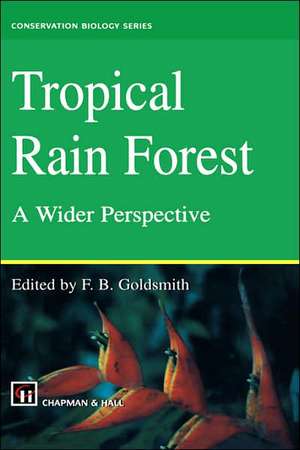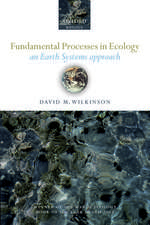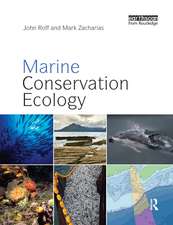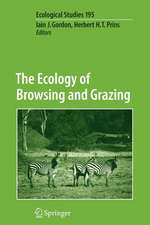Tropical Rain Forest: A Wider Perspective: Conservation Biology, cartea 10
Editat de F. B. Goldsmithen Limba Engleză Hardback – 31 ian 1998
| Toate formatele și edițiile | Preț | Express |
|---|---|---|
| Paperback (1) | 951.29 lei 6-8 săpt. | |
| SPRINGER NETHERLANDS – 31 ian 1998 | 951.29 lei 6-8 săpt. | |
| Hardback (1) | 957.44 lei 6-8 săpt. | |
| SPRINGER NETHERLANDS – 31 ian 1998 | 957.44 lei 6-8 săpt. |
Din seria Conservation Biology
- 11%
 Preț: 510.79 lei
Preț: 510.79 lei -
 Preț: 396.12 lei
Preț: 396.12 lei - 11%
 Preț: 474.83 lei
Preț: 474.83 lei - 18%
 Preț: 997.88 lei
Preț: 997.88 lei -
 Preț: 428.90 lei
Preț: 428.90 lei - 11%
 Preț: 511.40 lei
Preț: 511.40 lei - 11%
 Preț: 521.80 lei
Preț: 521.80 lei - 15%
 Preț: 532.38 lei
Preț: 532.38 lei - 18%
 Preț: 1233.37 lei
Preț: 1233.37 lei - 11%
 Preț: 519.62 lei
Preț: 519.62 lei - 11%
 Preț: 482.28 lei
Preț: 482.28 lei - 18%
 Preț: 948.92 lei
Preț: 948.92 lei - 11%
 Preț: 599.15 lei
Preț: 599.15 lei - 14%
 Preț: 772.46 lei
Preț: 772.46 lei - 11%
 Preț: 425.79 lei
Preț: 425.79 lei - 15%
 Preț: 644.49 lei
Preț: 644.49 lei - 11%
 Preț: 526.94 lei
Preț: 526.94 lei - 11%
 Preț: 597.21 lei
Preț: 597.21 lei -
 Preț: 373.96 lei
Preț: 373.96 lei -
 Preț: 364.04 lei
Preț: 364.04 lei - 11%
 Preț: 475.17 lei
Preț: 475.17 lei - 15%
 Preț: 646.62 lei
Preț: 646.62 lei - 11%
 Preț: 505.11 lei
Preț: 505.11 lei - 18%
 Preț: 942.94 lei
Preț: 942.94 lei - 11%
 Preț: 600.56 lei
Preț: 600.56 lei - 24%
 Preț: 1058.91 lei
Preț: 1058.91 lei - 18%
 Preț: 1240.62 lei
Preț: 1240.62 lei - 11%
 Preț: 513.79 lei
Preț: 513.79 lei -
 Preț: 459.88 lei
Preț: 459.88 lei - 18%
 Preț: 944.36 lei
Preț: 944.36 lei - 24%
 Preț: 790.95 lei
Preț: 790.95 lei - 11%
 Preț: 567.97 lei
Preț: 567.97 lei
Preț: 957.44 lei
Preț vechi: 1167.61 lei
-18% Nou
Puncte Express: 1436
Preț estimativ în valută:
183.25€ • 190.59$ • 153.57£
183.25€ • 190.59$ • 153.57£
Carte tipărită la comandă
Livrare economică 14-28 martie
Preluare comenzi: 021 569.72.76
Specificații
ISBN-13: 9780412815102
ISBN-10: 0412815109
Pagini: 444
Ilustrații: XIX, 416 p.
Dimensiuni: 155 x 235 x 29 mm
Greutate: 0.79 kg
Ediția:1998
Editura: SPRINGER NETHERLANDS
Colecția Springer
Seria Conservation Biology
Locul publicării:Dordrecht, Netherlands
ISBN-10: 0412815109
Pagini: 444
Ilustrații: XIX, 416 p.
Dimensiuni: 155 x 235 x 29 mm
Greutate: 0.79 kg
Ediția:1998
Editura: SPRINGER NETHERLANDS
Colecția Springer
Seria Conservation Biology
Locul publicării:Dordrecht, Netherlands
Public țintă
ResearchCuprins
1 Tropical rain forests - what are they really like?.- 1.1 Where are rain forests?.- 1.2 How fast is rain forest disappearing?.- 1.3 Definitions.- 1.4 Boundaries.- 1.5 So what are they really like?.- 1.6 Why so much diversity?.- 1.7 How serious is fragmentation?.- 1.8 Quantitative studies in rain forest.- 1.9 Case study: Tiwai Island.- 1.10 Sketch from the Amazon.- 1.11 Other regional studies.- 1.12 Conclusions.- Acknowledgements.- References.- 2 Indigenous non-timber benefits from tropical rain forest.- 2.1 Introduction.- 2.2 Indigenous use of the forest.- 2.3 Indigenous management of plant resources.- 2.4 Extractive reserves.- 2.5 Sustainability.- 2.6 The Convention on Biological Diversity.- 2.7 Oligarchic forests.- 2.8 Timber and non-timber forest products.- 2.9 Conclusions.- References.- 3 Degeneration versus regeneration — logging in tropical rain forests.- 3.1 Regeneration of tropical rain forests.- 3.2 Silvicultural systems.- 3.3 The effects of logging on forest structure and composition.- 3.4 The hydrological cycle in tropical rain forests.- 3.5 The effects of logging on forest hydrology and erosion.- 3.6 Impact on animal populations.- 3.7 Conclusions.- References.- 4 Forests people and conservation initiatives: the cultural context of rain forest conservation in West Africa.- 4.1 Who are the indigenes?.- 4.2 First the forest: villages and the socialization of space.- 4.3 Forest destruction: who are the villains?.- 4.4 Myths revisited: environmental management plans and local realities.- 4.5 Not all doom and gloom — engagement of conservation with local aspirations.- 4.6 The UCL/ODA community forest management project.- 4.7 Conclusion: forest futures, forest cultures.- Acknowledgement.- References.- 5 Forest and Environmental degradation.- 5.1 Forestdegradation.- 5.2 Biophysical implications of forest degradation.- 5.3 Strategies for forest conservation.- References.- 6 Soil and vegetation effects of tropical deforestation.- 6.1 Introduction.- 6.2 Effects of different deforestation practices on soil and vegetation.- 6.3 Deforestation effects on microclimate.- 6.4 Deforestation effects on soil physical properties.- 6.5 Deforestation effects on soil erosion.- 6.6 Deforestation effects on soil chemical properties.- 6.7 Changes in soil conditions with time after deforestation.- 6.8 Deforestation effects on soil biology.- 6.9 Deforestation effects on vegetation.- 6.10 Conclusions.- References.- 7 Causes of tropical deforestation and institutional constraints to conservation.- 7.1 Deforestation rates.- 7.2 Causes of deforestation.- 7.3 Institutional constraints.- 7.4 Conclusions.- Acknowledgements.- References.- 8 The economics of the tropical timber trade and sustainable forest management.- 8.1 Introduction.- 8.2 Trends in forest products trade and deforestation.- 8.3 Market access and trade barriers.- 8.4 Certification and labelling.- 8.5 The costs of implementing sustainable forest management.- 8.6 Financing sustainable forest management.- 8.7 Summary and conclusions.- References.- 9 Can non-market values save the tropical forests?.- 9.1 Introduction: the forest crisis.- 9.2 What do we know about non-market values?.- 9.3 Will non-timber values save the forests?.- Acknowledgement.- References.- 10 The role of policy and institutions.- 10.1 Why policy matters: dealing with multiple interests and change.- 10.2 Policy influences on forests.- 10.3 Policy challenges for sustainability — national and international.- 10.4 Institutions and stakeholders.- 10.5 Emerging lessons on ‘policy that works’.- 10.6 Signs ofchange.- References.- 11 Modelling tropical land use change and deforestation.- 11.1 Introduction.- 11.2 Background.- 11.3 A theoretical model of the causes of deforestation.- 11.4 Regression models of the causes of deforestation.- 11.5 Theoretical models of trends in forest cover.- 11.6 Modelling trends in forest cover.- 11.7 Modelling long-term spatial deforestation trends.- 11.8 Conclusions.- References.- 12 Communicating the message: a case study from the Royal Botanic Gardens, Kew.- 12.1 Introduction.- 12.2 What is the message and why should we bother?.- 12.3 Types of audience.- 12.4 Resources available.- 12.5 Is the message getting across?.- 12.6 Conclusions.- References.- 13 Effective campaigning.- 13.1 The campaigners.- 13.2 The campaign — origins and impacts.- 13.3 The timber trade — importing deforestation.- 13.4 The private sector in the rain forests.- 13.5 Aid, development, the international financial institutions and the rain forests.- 13.6 International agreements.- 13.7 Rain forests — campaign priorities for the future.- 13.8 Conclusions.- Acknowledgements.- References.- 14 Synthesis.- 14.1 Production.- 14.2 Protection.- 14.3 Conservation.- 14.4 Services for people.- 14.5 Policies and institutions.- 14.6 Knowledge base.- References.- List of acronyms.
Recenzii
`I cannot speak too highly of this book - the overall standard of presentation and production is excellent. It should be on the reading list of all university biology and environmental science courses, since it is the products of such courses who must deal with the major challenge facing our own species in the next 50 years: the sensible stewardship of the remaining forests. It also merits a place in school libraries, and will serve to provide a wealth of information to the concerned lay reader who seeks accessible, up-to-date information on the complexities of forest conservation.'
Biologist, 46:1 (1999)
`An elegant glimpse of the complex issues involved... An impressive and tightly-edited interdisciplinary effort that highlights most key topics... Unusually comprehensive in scope in comparison with other books... An important teaching book and reference book for any library.'
Northeastern Naturalist, 7:2
Biologist, 46:1 (1999)
`An elegant glimpse of the complex issues involved... An impressive and tightly-edited interdisciplinary effort that highlights most key topics... Unusually comprehensive in scope in comparison with other books... An important teaching book and reference book for any library.'
Northeastern Naturalist, 7:2















